engine YAMAHA YZ450F 2014 User Guide
[x] Cancel search | Manufacturer: YAMAHA, Model Year: 2014, Model line: YZ450F, Model: YAMAHA YZ450F 2014Pages: 360, PDF Size: 11.76 MB
Page 25 of 360
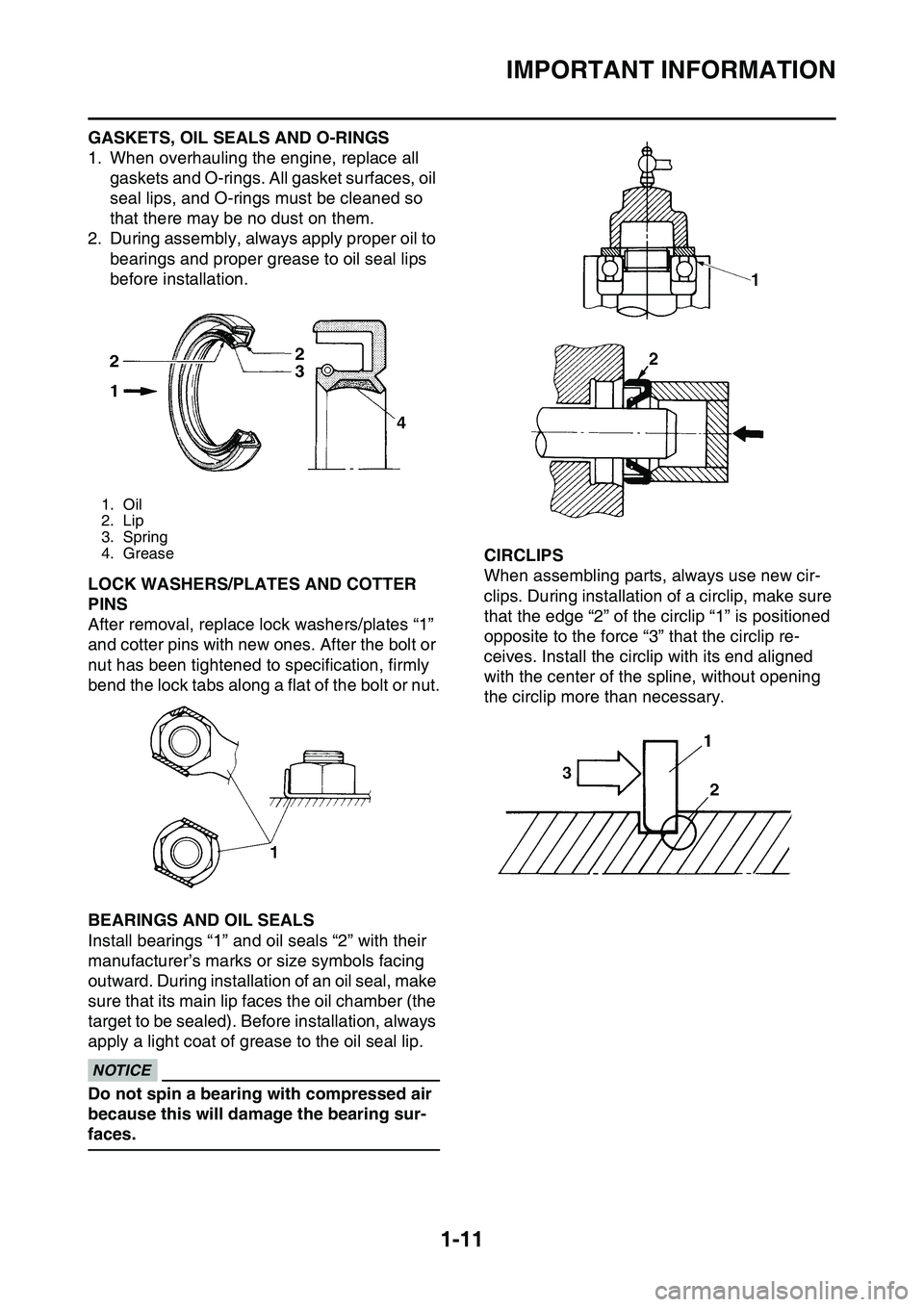
IMPORTANT INFORMATION
1-11
GASKETS, OIL SEALS AND O-RINGS
1. When overhauling the engine, replace all
gaskets and O-rings. All gasket surfaces, oil
seal lips, and O-rings must be cleaned so
that there may be no dust on them.
2. During assembly, always apply proper oil to
bearings and proper grease to oil seal lips
before installation.
EAS1SL1026LOCK WASHERS/PLATES AND COTTER
PINS
After removal, replace lock washers/plates “1”
and cotter pins with new ones. After the bolt or
nut has been tightened to specification, firmly
bend the lock tabs along a flat of the bolt or nut.
EAS1SL1027BEARINGS AND OIL SEALS
Install bearings “1” and oil seals “2” with their
manufacturer’s marks or size symbols facing
outward. During installation of an oil seal, make
sure that its main lip faces the oil chamber (the
target to be sealed). Before installation, always
apply a light coat of grease to the oil seal lip.
ECA13300
NOTICE
Do not spin a bearing with compressed air
because this will damage the bearing sur
-
faces.
EAS1SL1028CIRCLIPS
When assembling parts, always use new cir-
clips. During installation of a circlip, make sure
that the edge “2” of the circlip “1” is positioned
opposite to the force “3” that the circlip re
-
ceives. Install the circlip with its end aligned
with the center of the spline, without opening
the circlip more than necessary.
1. Oil
2. Lip
3. Spring
4. Grease
Page 33 of 360
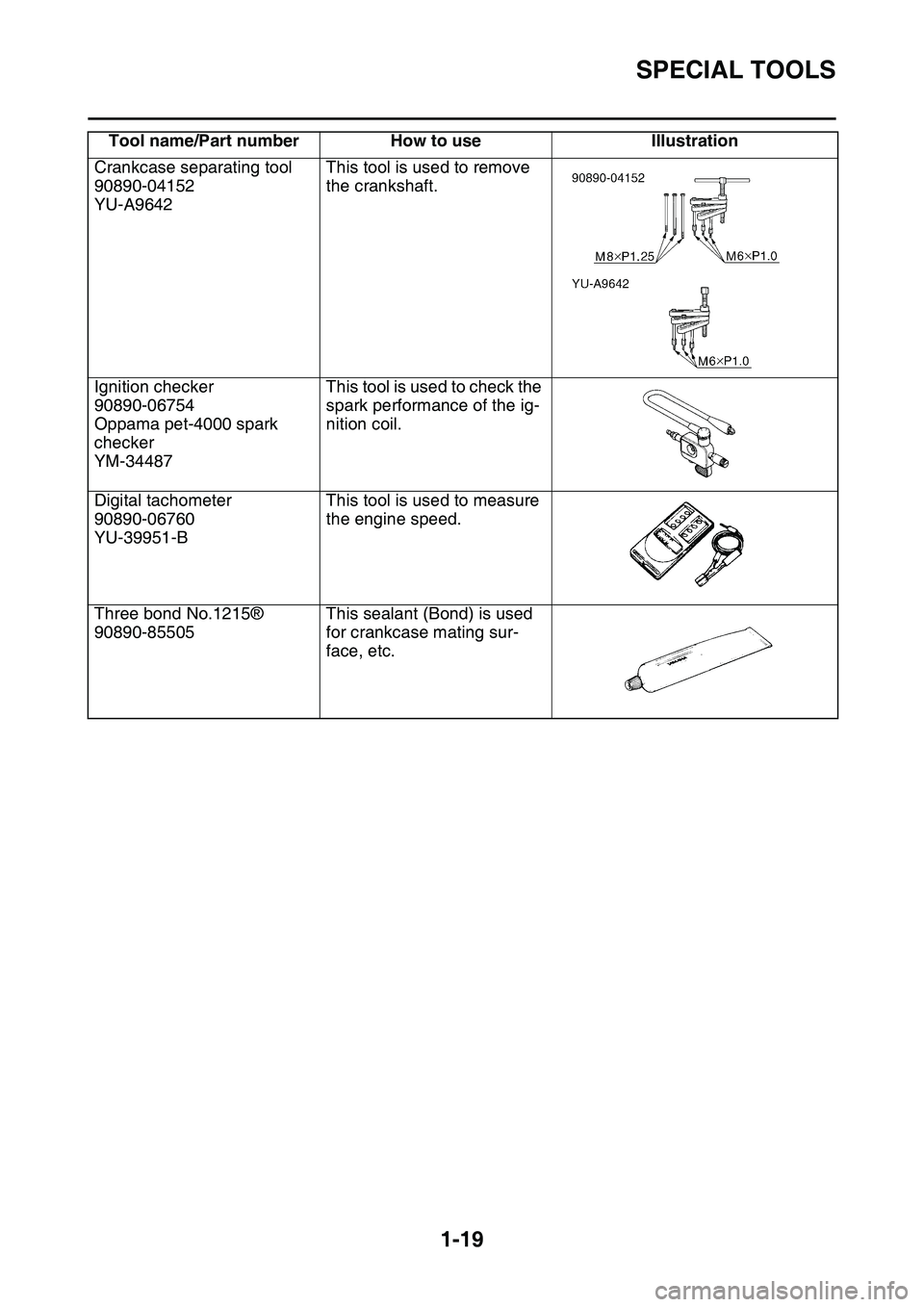
SPECIAL TOOLS
1-19
Crankcase separating tool
90890-04152
YU-A9642
This tool is used to remove
the crankshaft.
Ignition checker
90890-06754
Oppama pet-4000 spark
checker
YM-34487
This tool is used to check the
spark performance of the ig
-
nition coil.
Digital tachometer
90890-06760
YU-39951-B
This tool is used to measure
the engine speed.
Three bond No.1215®
90890-85505
This sealant (Bond) is used
for crankcase mating sur
-
face, etc.
Tool name/Part number How to use Illustration
Page 34 of 360
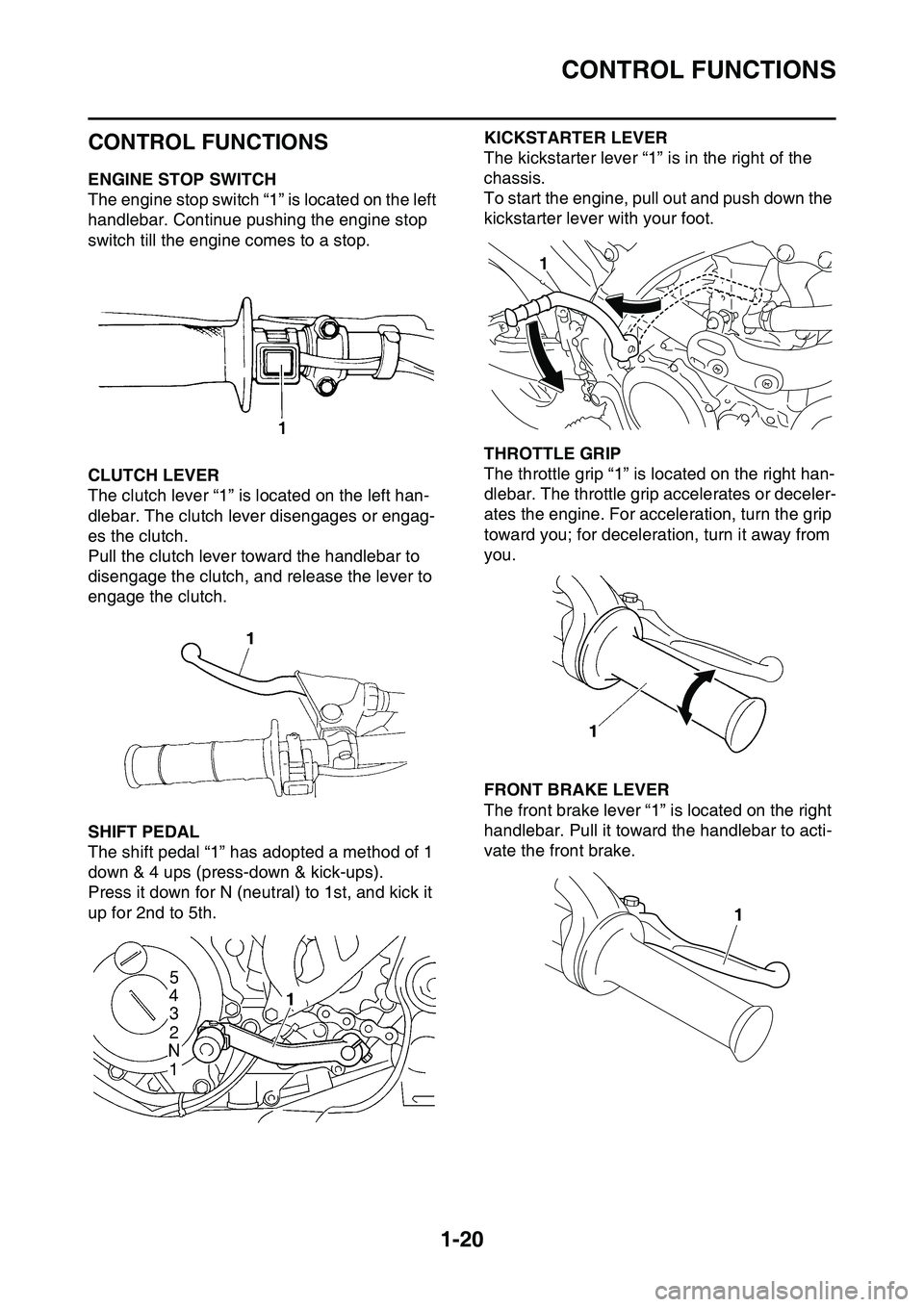
CONTROL FUNCTIONS
1-20
EAS1SL1032
CONTROL FUNCTIONS
EAS1SL1033ENGINE STOP SWITCH
The engine stop switch “1” is located on the left
handlebar. Continue pushing the engine stop
switch till the engine comes to a stop.
EAS1SL1034CLUTCH LEVER
The clutch lever “1” is located on the left han-
dlebar. The clutch lever disengages or engag-
es the clutch.
Pull the clutch lever toward the handlebar to
disengage the clutch, and release the lever to
engage the clutch.
EAS1SL1035SHIFT PEDAL
The shift pedal “1” has adopted a method of 1
down & 4 ups (press-down & kick-ups).
Press it down for N (neutral) to 1st, and kick it
up for 2nd to 5th.
EAS1SL1036
KICKSTARTER LEVER
The kickstarter lever “1” is in the right of the
chassis.
To start the engine, pull out and push down the
kickstarter lever with your foot.
EAS1SL1037THROTTLE GRIP
The throttle grip “1” is located on the right han-
dlebar. The throttle grip accelerates or deceler-
ates the engine. For acceleration, turn the grip
toward you; for deceleration, turn it away from
you.
EAS1SL1038FRONT BRAKE LEVER
The front brake lever “1” is located on the right
handlebar. Pull it toward the handlebar to acti
-
vate the front brake.
EAS1SL1039
1
1
Page 35 of 360
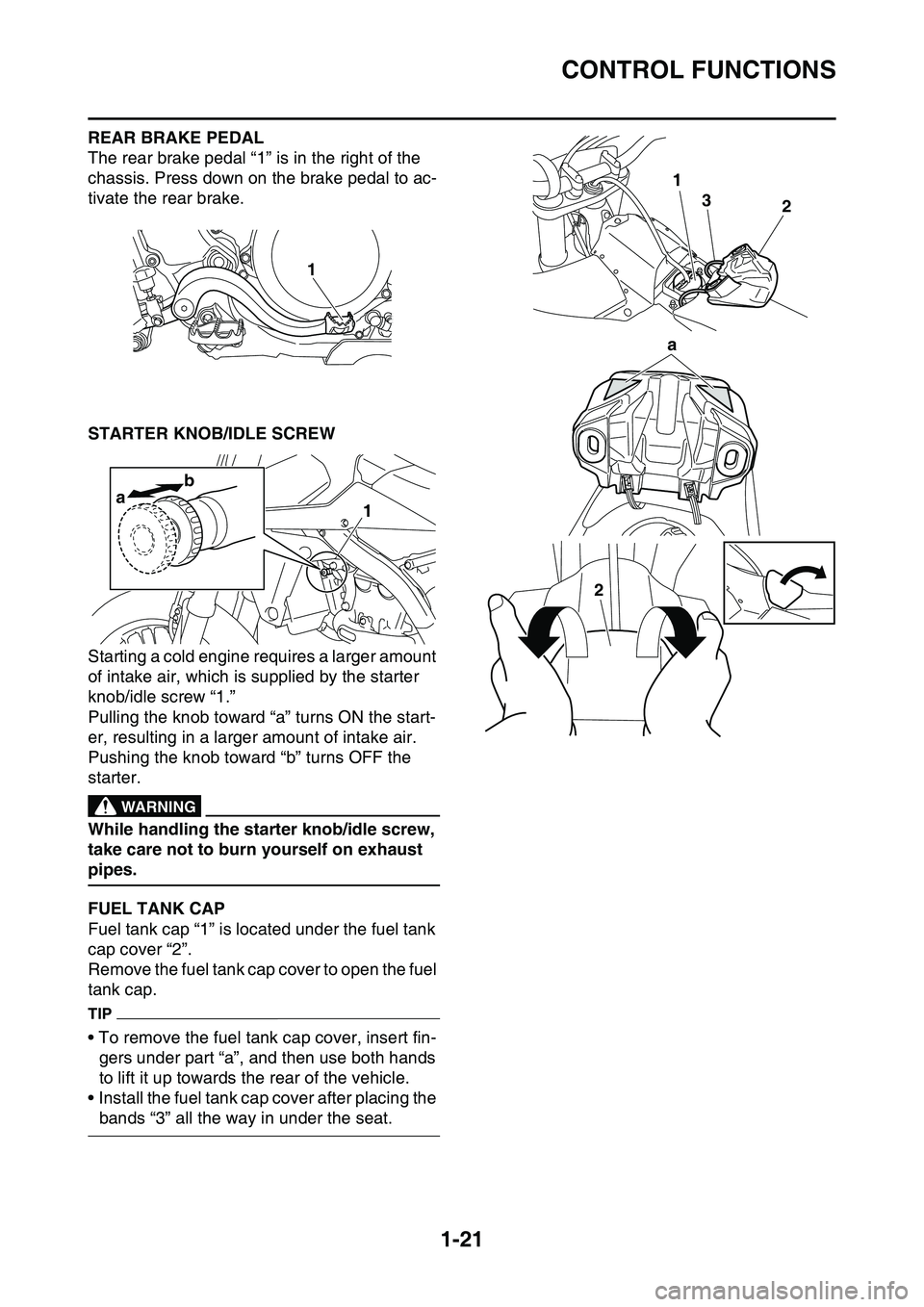
CONTROL FUNCTIONS
1-21
REAR BRAKE PEDAL
The rear brake pedal “1” is in the right of the
chassis. Press down on the brake pedal to ac-
tivate the rear brake.
EAS1SL1040STARTER KNOB/IDLE SCREW
Starting a cold engine requires a larger amount
of intake air, which is supplied by the starter
knob/idle screw “1.”
Pulling the knob toward “a” turns ON the start-
er, resulting in a larger amount of intake air.
Pushing the knob toward “b” turns OFF the
starter.
EWA@
WARNING
While handling the starter knob/idle screw,
take care not to burn yourself on exhaust
pipes.
EAS1SL1040FUEL TANK CAP
Fuel tank cap “1” is located under the fuel tank
cap cover “2”.
Remove the fuel tank cap cover to open the fuel
tank cap.
TIP
• To remove the fuel tank cap cover, insert fin-gers under part “a”, and then use both hands
to lift it up towards the rear of the vehicle.
• Install the fuel tank cap cover after placing the
bands “3” all the way in under the seat.
1
a b1
1
23
a
2
Page 36 of 360
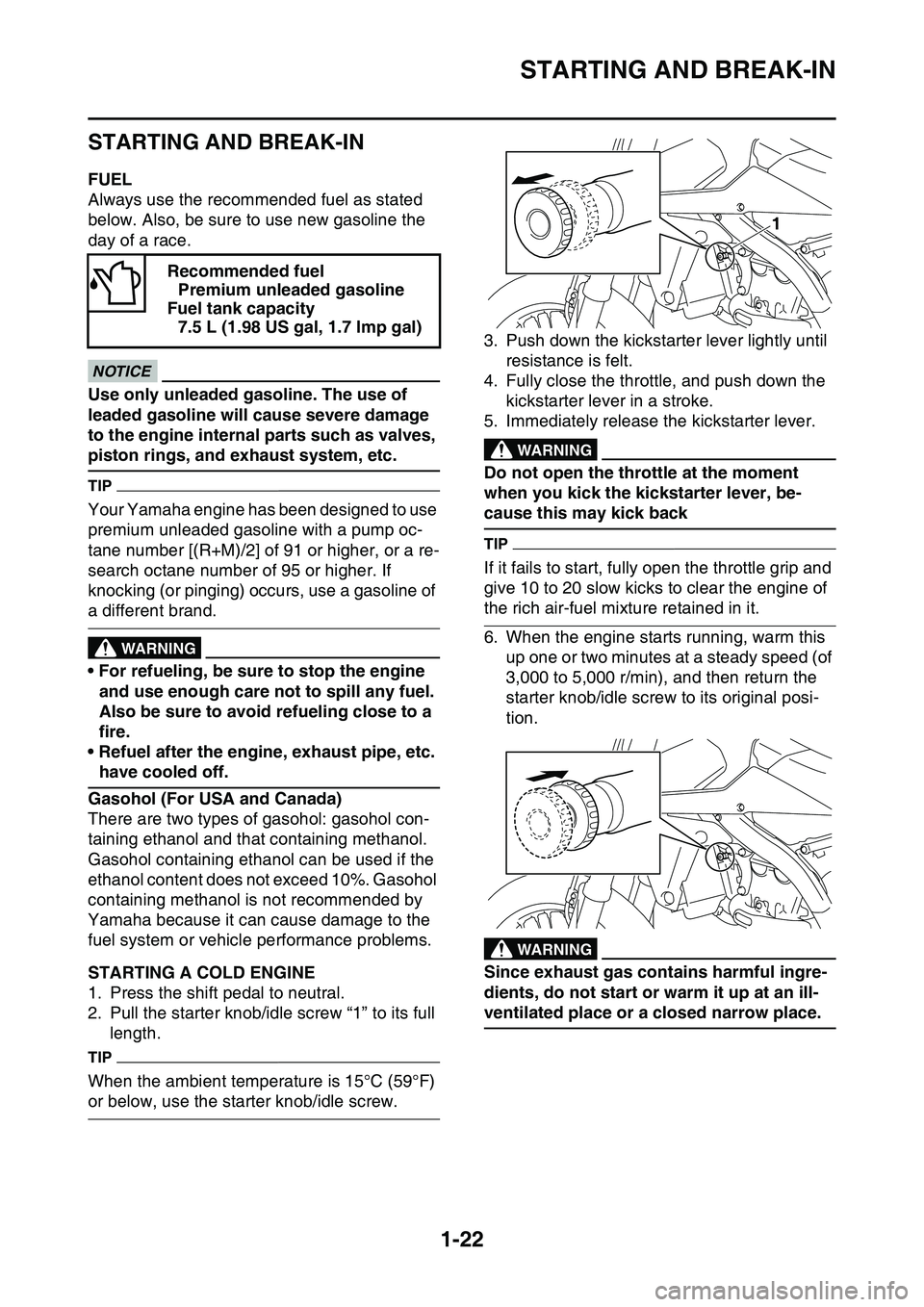
STARTING AND BREAK-IN
1-22
EAS1SL1041
STARTING AND BREAK-IN
EAS1SL1042FUEL
Always use the recommended fuel as stated
below. Also, be sure to use new gasoline the
day of a race.
JCA
NOTICE
Use only unleaded gasoline. The use of
leaded gasoline will cause severe damage
to the engine internal parts such as valves,
piston rings, and exhaust system, etc.
TIP
Your Yamaha engine has been designed to use
premium unleaded gasoline with a pump oc
-
tane number [(R+M)/2] of 91 or higher, or a re-
search octane number of 95 or higher. If
knocking (or pinging) occurs, use a gasoline of
a different brand.
JWA
WARNING
• For refueling, be sure to stop the engine
and use enough care not to spill any fuel.
Also be sure to avoid refueling close to a
fire.
• Refuel after the engine, exhaust pipe, etc.
have cooled off.
Gasohol (For USA and Canada)
There are two types of gasohol: gasohol con-
taining ethanol and that containing methanol.
Gasohol containing ethanol can be used if the
ethanol content does not exceed 10%. Gasohol
containing methanol is not recommended by
Yamaha because it can cause damage to the
fuel system or vehicle performance problems.
EAS1SL1043STARTING A COLD ENGINE
1. Press the shift pedal to neutral.
2. Pull the starter knob/idle screw “1” to its full
length.
TIP
When the ambient temperature is 15°C (59°F)
or below, use the starter knob/idle screw.
3. Push down the kickstarter lever lightly until
resistance is felt.
4. Fully close the throttle, and push down the
kickstarter lever in a stroke.
5. Immediately release the kickstarter lever.EWA
WARNING
Do not open the throttle at the moment
when you kick the kickstarter lever, be
-
cause this may kick back
TIP
If it fails to start, fully open the throttle grip and
give 10 to 20 slow kicks to clear the engine of
the rich air-fuel mixture retained in it.
6. When the engine starts running, warm this
up one or two minutes at a steady speed (of
3,000 to 5,000 r/min), and then return the
starter knob/idle screw to its original posi
-
tion.
EWA
WARNING
Since exhaust gas contains harmful ingre-
dients, do not start or warm it up at an ill-
ventilated place or a closed narrow place.
Recommended fuel
Premium unleaded gasoline
Fuel tank capacity
7.5 L (1.98 US gal, 1.7 lmp gal)
1
Page 37 of 360
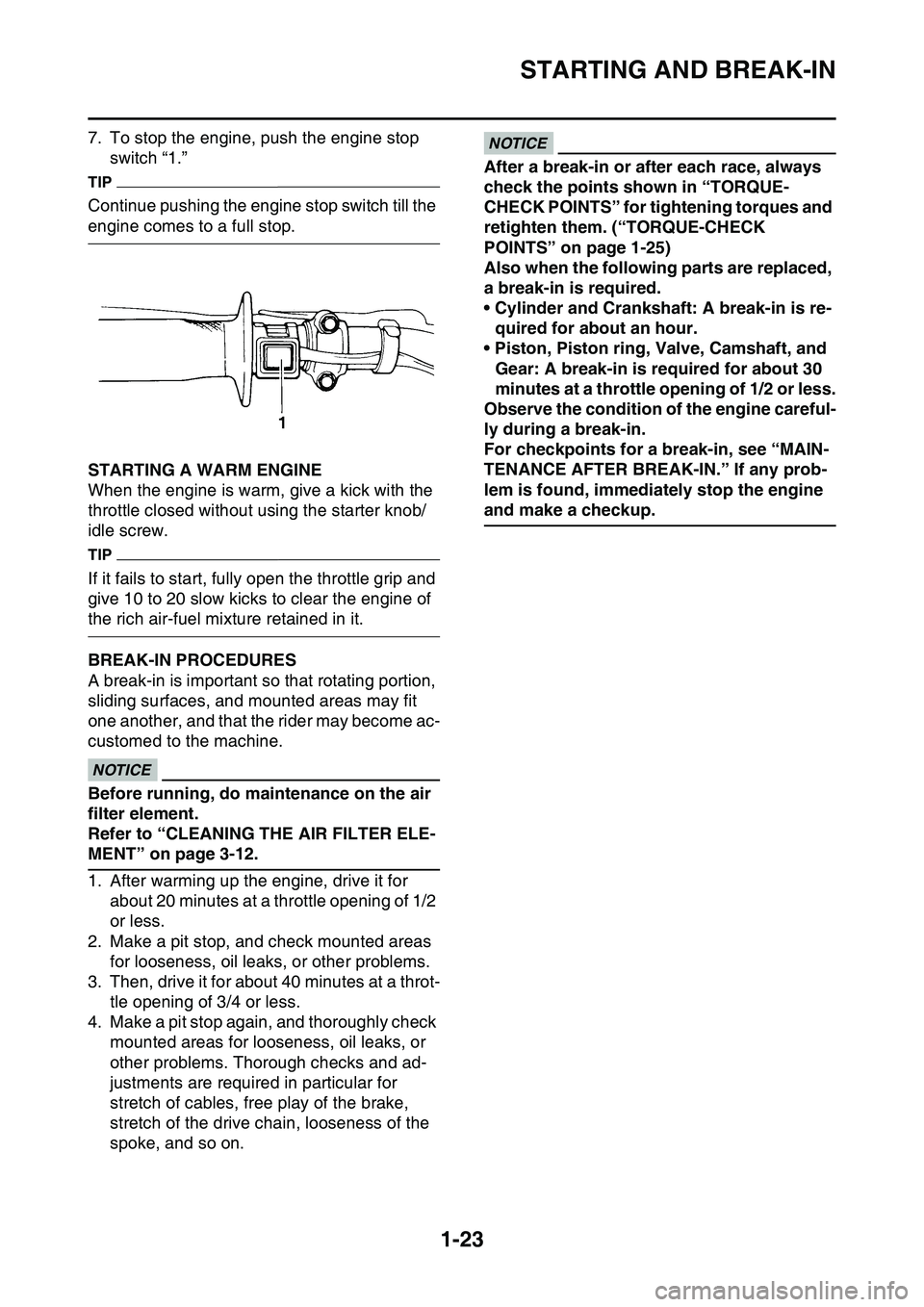
STARTING AND BREAK-IN
1-23
7. To stop the engine, push the engine stop
switch “1.”
TIP
Continue pushing the engine stop switch till the
engine comes to a full stop.
EAS1SL1044STARTING A WARM ENGINE
When the engine is warm, give a kick with the
throttle closed without using the starter knob/
idle screw.
TIP
If it fails to start, fully open the throttle grip and
give 10 to 20 slow kicks to clear the engine of
the rich air-fuel mixture retained in it.
EAS1SL1045BREAK-IN PROCEDURES
A break-in is important so that rotating portion,
sliding surfaces, and mounted areas may fit
one another, and that the rider may become ac
-
customed to the machine.ECA
NOTICE
Before running, do maintenance on the air
filter element.
Refer to “CLEANING THE AIR FILTER ELE-
MENT” on page 3-12.
1. After warming up the engine, drive it for
about 20 minutes at a throttle opening of 1/2
or less.
2. Make a pit stop, and check mounted areas
for looseness, oil leaks, or other problems.
3. Then, drive it for about 40 minutes at a throt-
tle opening of 3/4 or less.
4. Make a pit stop again, and thoroughly check
mounted areas for looseness, oil leaks, or
other problems. Thorough checks and ad
-
justments are required in particular for
stretch of cables, free play of the brake,
stretch of the drive chain, looseness of the
spoke, and so on.
ECA
NOTICE
After a break-in or after each race, always
check the points shown in “TORQUE-
CHECK POINTS” for tightening torques and
retighten them. (
“TORQUE-CHECK
POINTS” on page 1-25)
Also when the following parts are replaced,
a break-in is required.
• Cylinder and Crankshaft: A break-in is re-
quired for about an hour.
• Piston, Piston ring, Valve, Camshaft, and
Gear: A break-in is required for about 30
minutes at a throttle opening of 1/2 or less.
Observe the condition of the engine careful-
ly during a break-in.
For checkpoints for a break-in, see “MAIN-
TENANCE AFTER BREAK-IN.” If any prob-
lem is found, immediately stop the engine
and make a checkup.
EAS1SL1046
Page 38 of 360
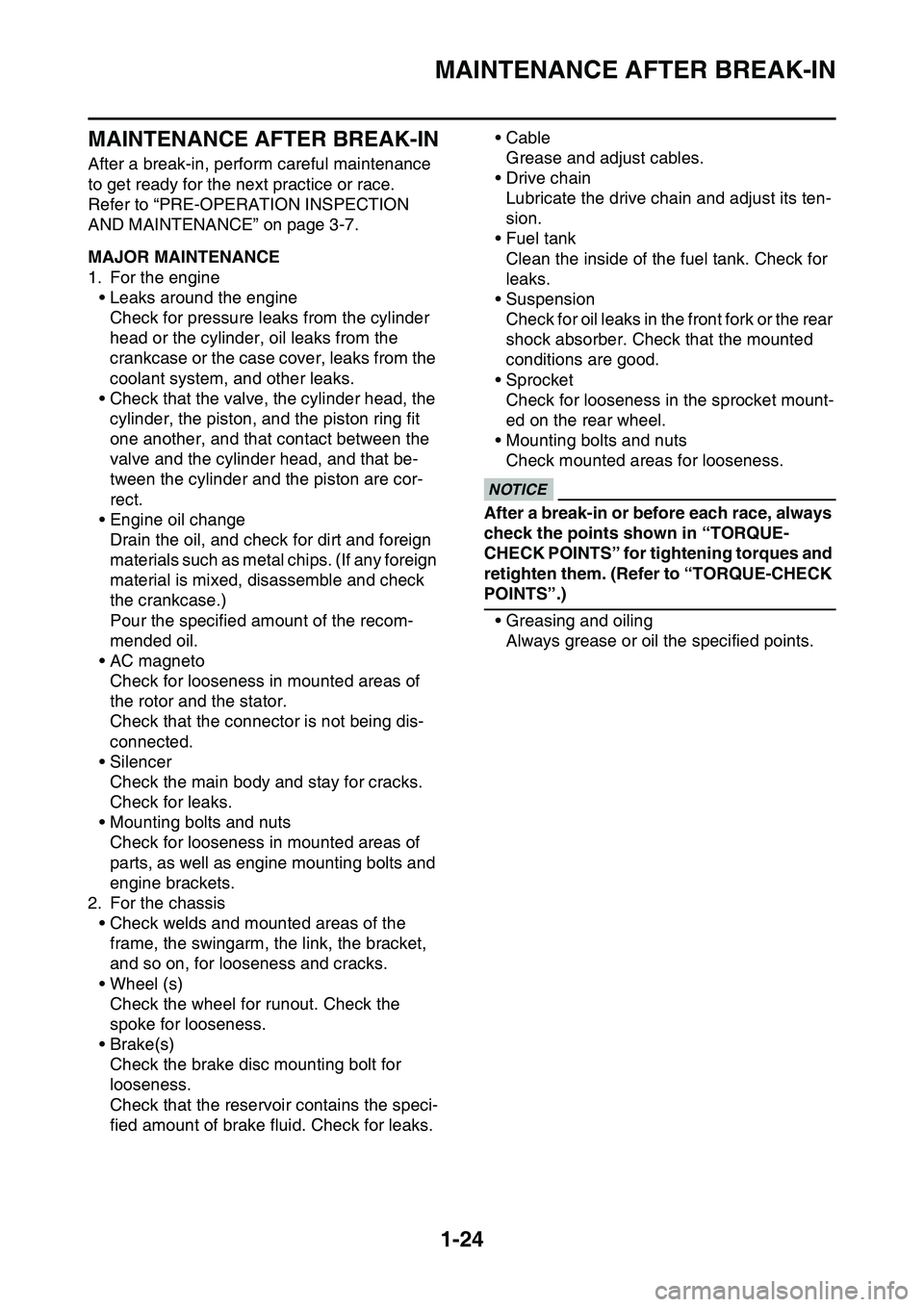
MAINTENANCE AFTER BREAK-IN
1-24
MAINTENANCE AFTER BREAK-IN
After a break-in, perform careful maintenance
to get ready for the next practice or race.
Refer to “PRE-OPERATION INSPECTION
AND MAINTENANCE” on page 3-7.
EAS1SL1047MAJOR MAINTENANCE
1. For the engine
• Leaks around the engine
Check for pressure leaks from the cylinder
head or the cylinder, oil leaks from the
crankcase or the case cover, leaks from the
coolant system, and other leaks.
• Check that the valve, the cylinder head, the
cylinder, the piston, and the piston ring fit
one another, and that contact between the
valve and the cylinder head, and that be
-
tween the cylinder and the piston are cor-
rect.
• Engine oil change
Drain the oil, and check for dirt and foreign
materials such as metal chips. (If any foreign
material is mixed, disassemble and check
the crankcase.)
Pour the specified amount of the recom-
mended oil.
• AC magneto
Check for looseness in mounted areas of
the rotor and the stator.
Check that the connector is not being dis-
connected.
• Silencer
Check the main body and stay for cracks.
Check for leaks.
• Mounting bolts and nuts
Check for looseness in mounted areas of
parts, as well as engine mounting bolts and
engine brackets.
2. For the chassis
• Check welds and mounted areas of the
frame, the swingarm, the link, the bracket,
and so on, for looseness and cracks.
• Wheel (s)
Check the wheel for runout. Check the
spoke for looseness.
• Brake(s)
Check the brake disc mounting bolt for
looseness.
Check that the reservoir contains the speci-
fied amount of brake fluid. Check for leaks.
• Cable
Grease and adjust cables.
•Drive chain
Lubricate the drive chain and adjust its ten-
sion.
• Fuel tank
Clean the inside of the fuel tank. Check for
leaks.
• Suspension
Check for oil leaks in the front fork or the rear
shock absorber. Check that the mounted
conditions are good.
• Sprocket
Check for looseness in the sprocket mount-
ed on the rear wheel.
• Mounting bolts and nuts
Check mounted areas for looseness.JCA1SL1001
NOTICE
After a break-in or before each race, always
check the points shown in “TORQUE-
CHECK POINTS” for tightening torques and
retighten them. (Refer to
“TORQUE-CHECK
POINTS”.)
• Greasing and oiling
Always grease or oil the specified points.
Page 39 of 360
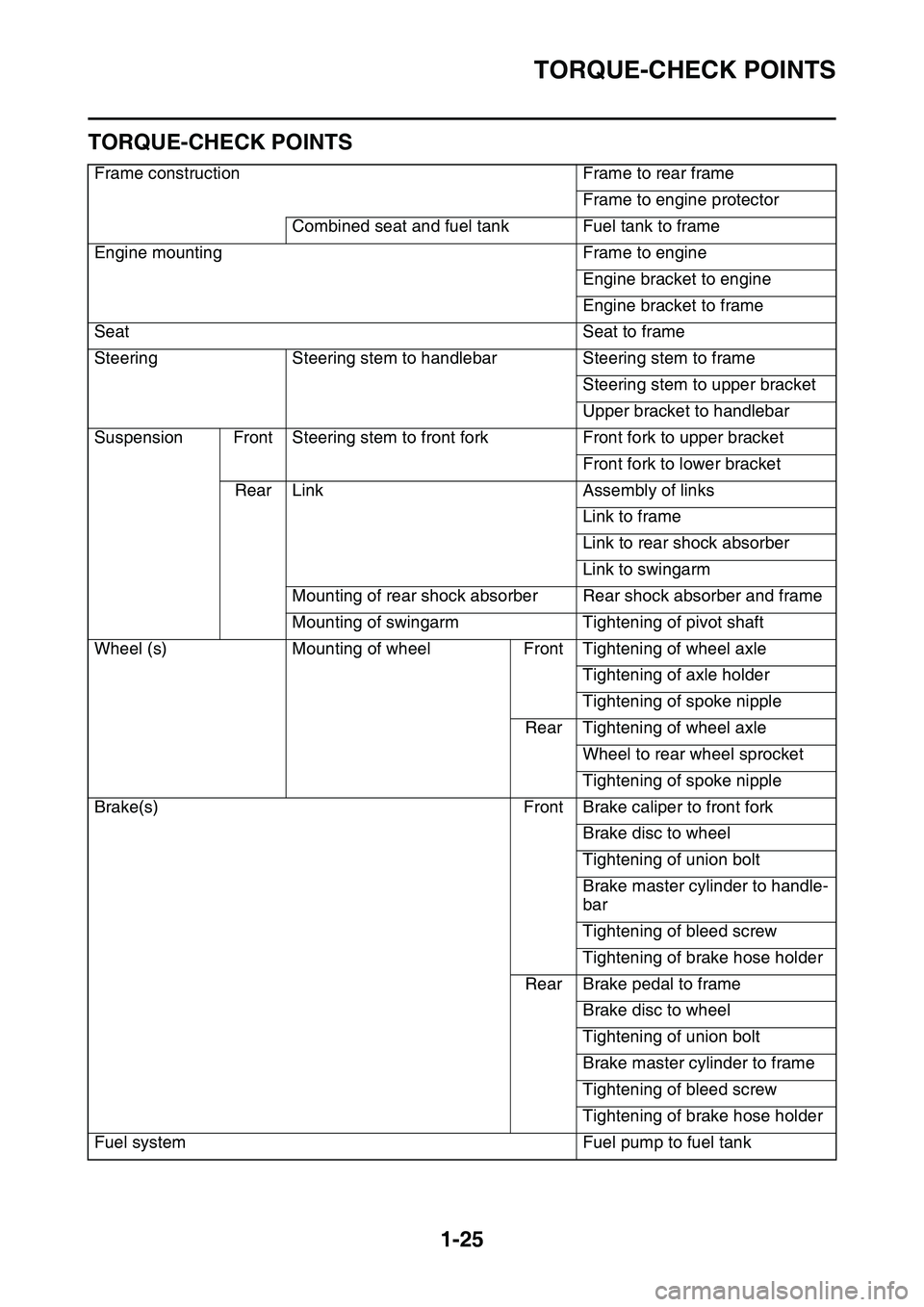
TORQUE-CHECK POINTS
1-25
EAS1SL1048
TORQUE-CHECK POINTS
Frame constructionFrame to rear frame
Frame to engine protector
Combined seat and fuel tankFuel tank to frame
Engine mountingFrame to engine
Engine bracket to engine
Engine bracket to frame
SeatSeat to frame
SteeringSteering stem to handlebarSteering stem to frame
Steering stem to upper bracket
Upper bracket to handlebar
SuspensionFrontSteering stem to front forkFront fork to upper bracket
Front fork to lower bracket
RearLinkAssembly of links
Link to frame
Link to rear shock absorber
Link to swingarm
Mounting of rear shock absorberRear shock absorber and frame
Mounting of swingarmTightening of pivot shaft
Wheel (s)Mounting of wheelFrontTightening of wheel axle
Tightening of axle holder
Tightening of spoke nipple
RearTightening of wheel axle
Wheel to rear wheel sprocket
Tightening of spoke nipple
Brake(s)FrontBrake caliper to front fork
Brake disc to wheel
Tightening of union bolt
Brake master cylinder to handle-
bar
Tightening of bleed screw
Tightening of brake hose holder
RearBrake pedal to frame
Brake disc to wheel
Tightening of union bolt
Brake master cylinder to frame
Tightening of bleed screw
Tightening of brake hose holder
Fuel systemFuel pump to fuel tank
Page 41 of 360
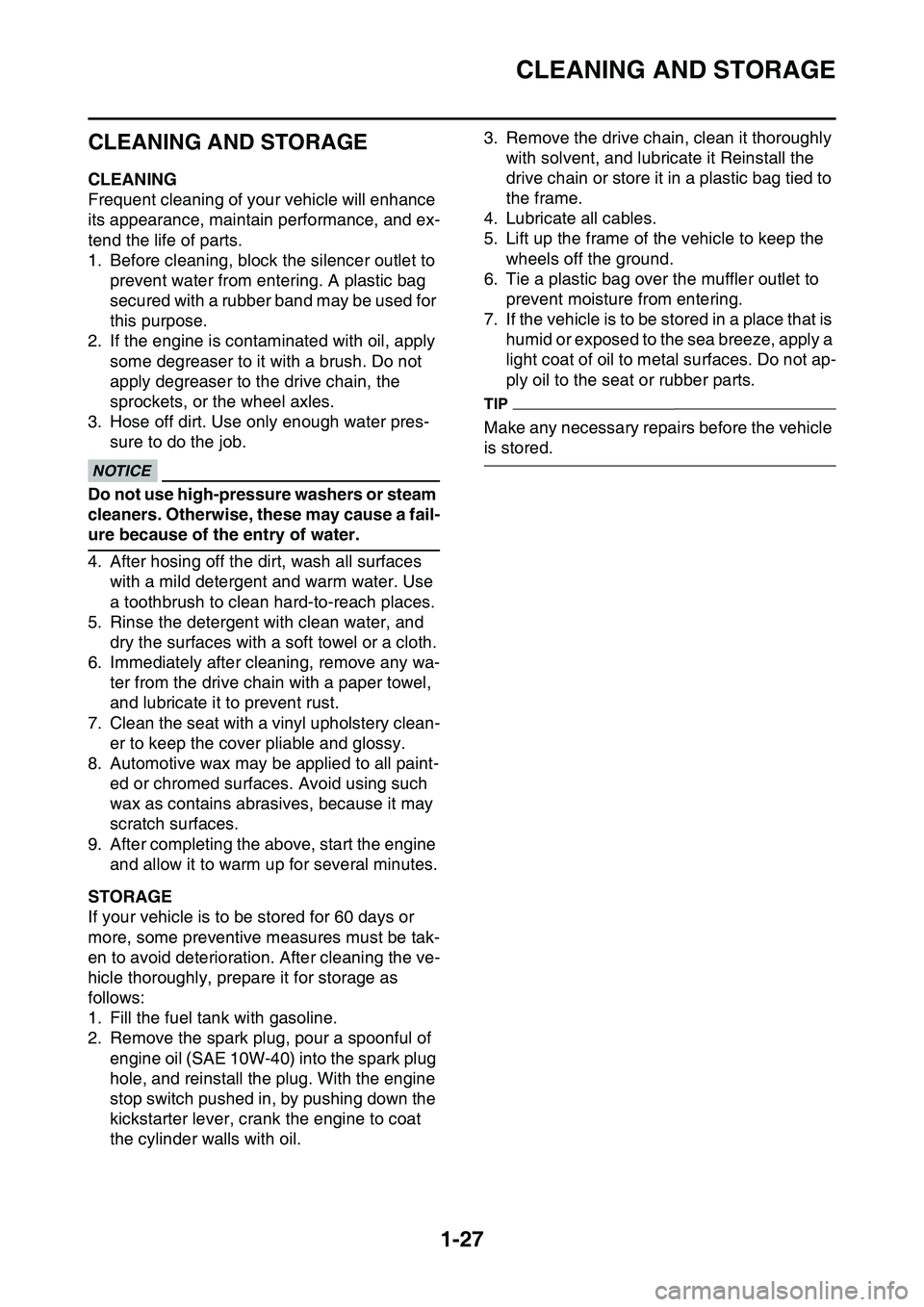
CLEANING AND STORAGE
1-27
EAS1SL1049
CLEANING AND STORAGE
EAS1SL1050CLEANING
Frequent cleaning of your vehicle will enhance
its appearance, maintain performance, and ex
-
tend the life of parts.
1. Before cleaning, block the silencer outlet to
prevent water from entering. A plastic bag
secured with a rubber band may be used for
this purpose.
2. If the engine is contaminated with oil, apply
some degreaser to it with a brush. Do not
apply degreaser to the drive chain, the
sprockets, or the wheel axles.
3. Hose off dirt. Use only enough water pres-
sure to do the job.ECA
NOTICE
Do not use high-pressure washers or steam
cleaners. Otherwise, these may cause a fail
-
ure because of the entry of water.
4. After hosing off the dirt, wash all surfaces
with a mild detergent and warm water. Use
a toothbrush to clean hard-to-reach places.
5. Rinse the detergent with clean water, and
dry the surfaces with a soft towel or a cloth.
6. Immediately after cleaning, remove any wa-
ter from the drive chain with a paper towel,
and lubricate it to prevent rust.
7. Clean the seat with a vinyl upholstery clean-
er to keep the cover pliable and glossy.
8. Automotive wax may be applied to all paint-
ed or chromed surfaces. Avoid using such
wax as contains abrasives, because it may
scratch surfaces.
9. After completing the above, start the engine
and allow it to warm up for several minutes.
EAS1SL1051STORAGE
If your vehicle is to be stored for 60 days or
more, some preventive measures must be tak
-
en to avoid deterioration. After cleaning the ve-
hicle thoroughly, prepare it for storage as
follows:
1. Fill the fuel tank with gasoline.
2. Remove the spark plug, pour a spoonful of
engine oil (SAE 10W-40) into the spark plug
hole, and reinstall the plug. With the engine
stop switch pushed in, by pushing down the
kickstarter lever, crank the engine to coat
the cylinder walls with oil.
3. Remove the drive chain, clean it thoroughly
with solvent, and lubricate it Reinstall the
drive chain or store it in a plastic bag tied to
the frame.
4. Lubricate all cables.
5. Lift up the frame of the vehicle to keep the
wheels off the ground.
6. Tie a plastic bag over the muffler outlet to
prevent moisture from entering.
7. If the vehicle is to be stored in a place that is
humid or exposed to the sea breeze, apply a
light coat of oil to metal surfaces. Do not ap
-
ply oil to the seat or rubber parts.
TIP
Make any necessary repairs before the vehicle
is stored.
Page 43 of 360
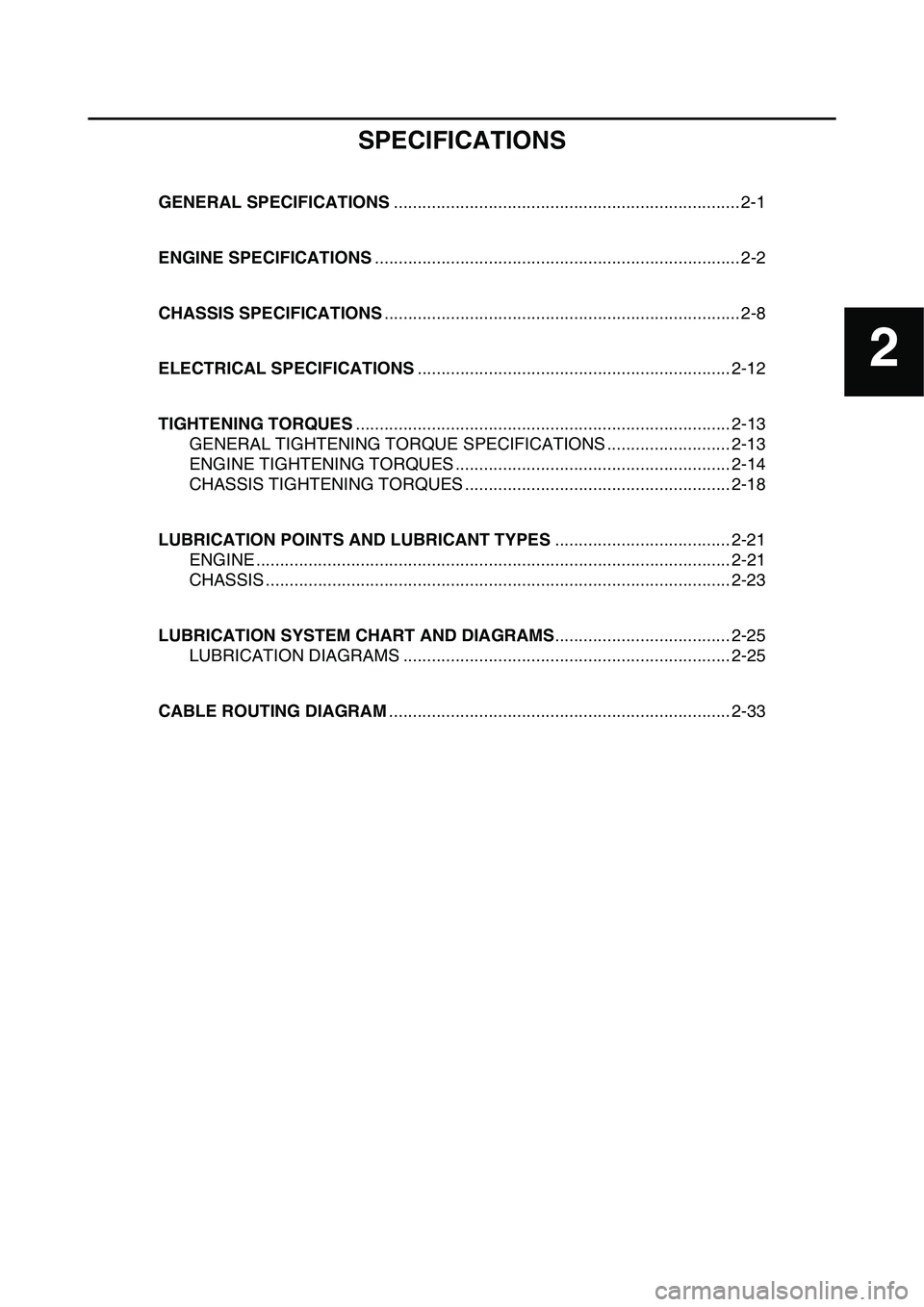
2
SPECIFICATIONS
GENERAL SPECIFICATIONS......................................................................... 2-1
ENGINE SPECIFICATIONS............................................................................. 2-2
CHASSIS SPECIFICATIONS........................................................................... 2-8
ELECTRICAL SPECIFICATIONS.................................................................. 2-12
TIGHTENING TORQUES............................................................................... 2-13
GENERAL TIGHTENING TORQUE SPECIFICATIONS .......................... 2-13
ENGINE TIGHTENING TORQUES .......................................................... 2-14
CHASSIS TIGHTENING TORQUES ........................................................ 2-18
LUBRICATION POINTS AND LUBRICANT TYPES..................................... 2-21
ENGINE .................................................................................................... 2-21
CHASSIS .................................................................................................. 2-23
LUBRICATION SYSTEM CHART AND DIAGRAMS..................................... 2-25
LUBRICATION DIAGRAMS ..................................................................... 2-25
CABLE ROUTING DIAGRAM........................................................................ 2-33